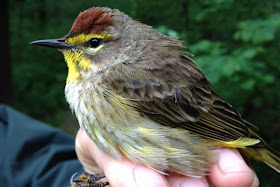For 2013, a
record number of migrating birds were banded at the World Bird Sanctuary from
April 21 through May 14.
Fifty-eight different species were captured, and
675 birds were encountered in all. This was up from an average of 300 in recent years.
This Tennessee Warbler is one of the more commonly caught birds. Photo by team member Colleen Crank
The most commonly caught were Tennessee Warblers (117), Nashville Warblers (106), and White-Throated Sparrows (101).
Brewster's Warbler photographed by Banding Team member Valerie Geile
Special birds caught the
spring of 2013 include Brewster’s, Golden-winged, Blue-winged, Myrtle, and
Chestnut-sided Warblers.
Kentucky Warbler photographed by WBS Banding Team member Linda Tossing
WBS Banders set up 23 difficult to
see mist nets in a wooded ravine to catch the birds. After being identified, measured, assessed, and banded the
birds were released. The
statistics collected were submitted to a database under the auspices of the federal Bird Banding Laboratory, which is part of the United States Geological Survey. The USGS issues permits to qualifying
banding organizations that place uniquely numbered bands on captured birds.
Male Rose Breasted Grosbeak photographed by Linda Tossing
The number on its band indicated
that one Nashville Warbler captured this year at the World Bird Sanctuary was
previously banded last fall in New York State. Generally birds follow one of four migration routes from
their wintering grounds in South and Central America to their nesting
territories in the northern United States and Canada. The birds fly over the east coast, up the Mississippi,
across the plains, or along the west coast. At times weather conditions may cause birds to detour from
their normal route.
Western Palm Warbler photographed by Becky Welter
The data accumulated from this study is useful to monitor
population growth or decline, life spans, migration paths, and survival
rates. Analysis of banding data can
also play a major role in monitoring the status of species of concern and
threatened or endangered species.
Changes in habitats for bird species may be reflected in capture
numbers. Banding is thus an important tool to further the understanding of bird
populations.
Birds have been banded for
centuries. The first record of a banded bird being recaptured was when one of
Henry IV's banded Peregrine Falcons was lost in France about 1595. It showed up
24 hours later in Malta, about 1350 miles away, averaging 56 miles an
hour! Duke Ferdinand placed a band
on a Grey Heron in 1669. This bird
was recovered by his grandson in 1728, indicating the heron lived at least 60
years.
The first records of banding in
North America are those of John James Audubon, the famous American naturalist
and painter. In 1803 he tied silver cords to the legs of Eastern Phoebes near Philadelphia. When they returned to the area the following year he was
able to identify two of the of the previous year’s nestlings.
Yellow-breasted Chat photographed by Becky Welter
Bird banders at the World Bird
Sanctuary are dedicated to monitoring bird numbers in the St. Louis area. They not only band daily during spring
migration, but they also band weekly throughout the summer and fall. Saw Whet Owls are captured during
special nightly sessions in October.
If you are interested in observing
the capture and banding process, public demonstrations are conducted every
first and third Thursday of June, July, and August near the hospital at the
World Bird Sanctuary, located off the intersection of highways 44 and 141, near
Valley Park, MO. For more
information visit worldbirdsanctuary.org.
Submitted by Mary Elise Sampson,
World Bird Sanctuary Bird Banding Team Member






Fantastic!
ReplyDelete